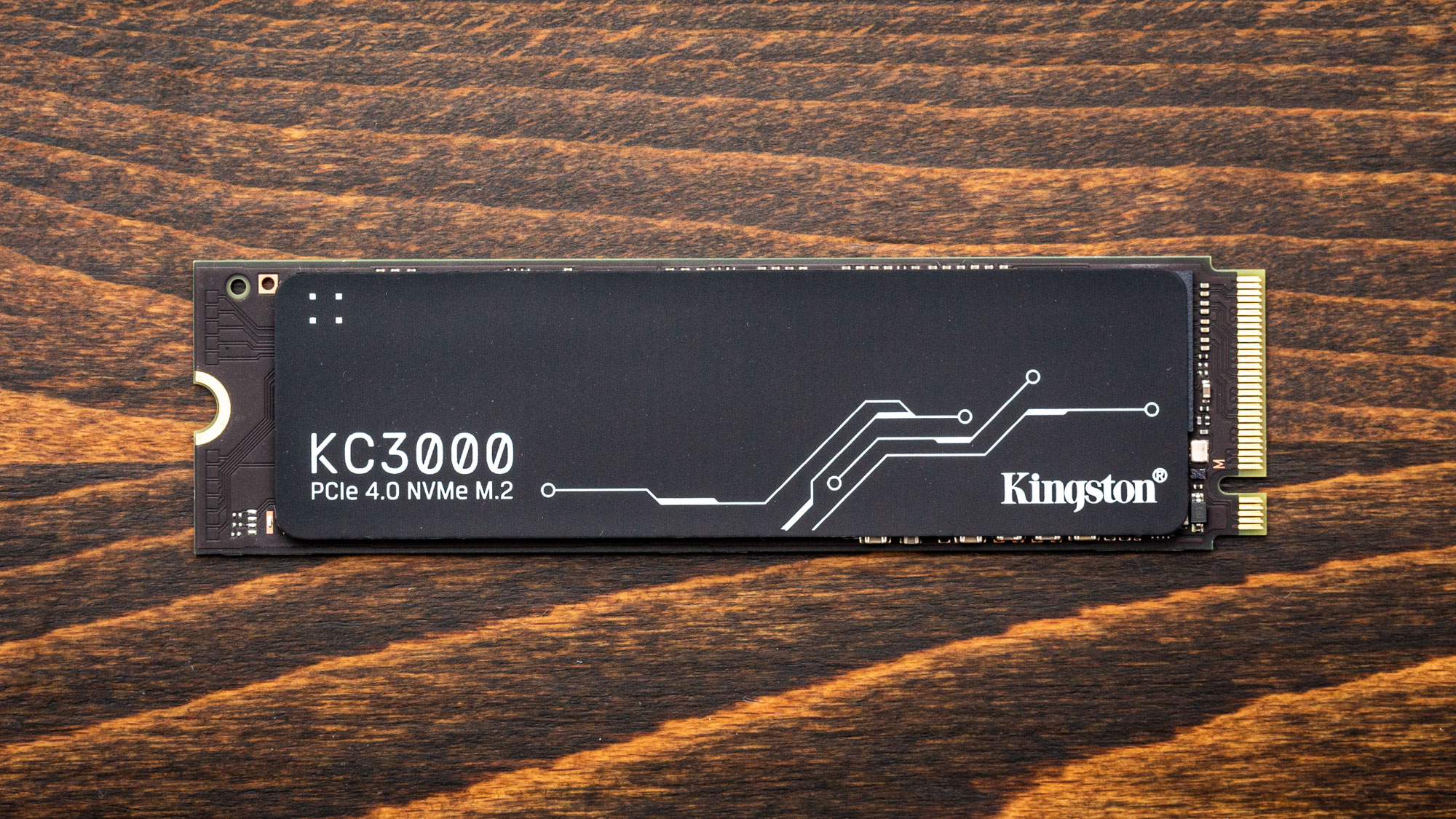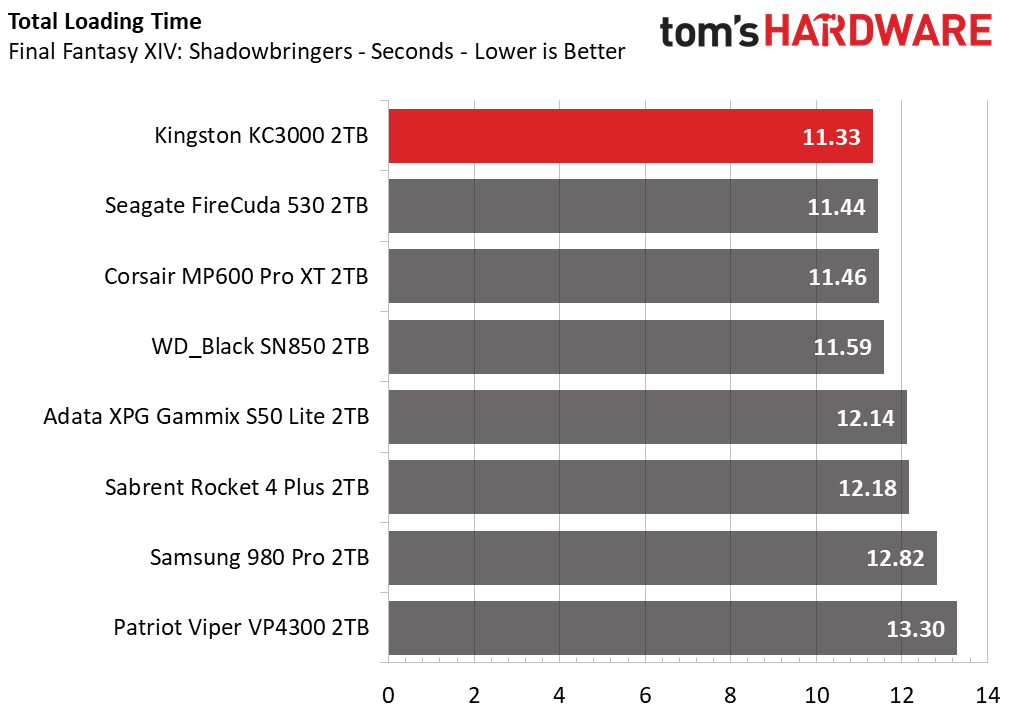Why you can trust Tom's Hardware
2TB Kingston KC3000
RATING: ★★★★½
PROS
+ Fast PCIe 4.0 performance and cool operation
+ Attractive design
+ 5-year warranty and high-endurance ratings
CONS
- Costly
- High power use
- Lacks AES hardware encryption
OUR VERDICT
With Micron’s 176L TLC clocking in at 1,600 MTps and responsive lab test results backing it, Kingston’s 2TB KC3000 proves itself as a top-tier PCIe 4.0 x4 NVMe SSD suited best for those looking for speed.
Get Tom's Hardware's best news and in-depth reviews, straight to your inbox.
Comparison Products
We pitted Kingston’s KC3000 against the best SSDs in the market. Of course, without a doubt, this includes the Seagate FireCuda 530, Corsair MP600 Pro XT, Samsung 980 Pro, and WD Black SN850. We also threw in the Sabrent Rocket 4 Plus, Patriot Viper VP4300, and Adata XPG Gammix S50 Lite for good measure.
Game Scene Loading - Final Fantasy XIV
Final Fantasy XIV Shadowbringers is a free real-world game benchmark that easily and accurately compares game load times without the inaccuracy of using a stopwatch.
In terms of its game load performance, the Kingston KC3000 proved the most responsive in this Final Fantasy XIV benchmark. It edged out the Seagate and Corsair drives, thanks to its faster flash speed.
Transfer Rates – DiskBench
We use the DiskBench storage benchmarking tool to test file transfer performance with a custom, 50GB dataset. We copy 31,227 files of various types, such as pictures, PDFs, and videos to a new folder and then follow-up with a reading test of a newly-written 6.5GB zip file.


Not only was the Kingston KC3000 faster in loading up each game scene in the Final Fantasy benchmark, but it also took the lead in file transfer tests. Kingston’s KC3000 managed to outperform both the Seagate FireCuda and Corsair MP600 Pro XT while leaving the WD Black SN850 and Samsung 980 Pro in the dust.
Trace Testing – PCMark 10 Storage Test
PCMark 10 is a trace-based benchmark that uses a wide-ranging set of real-world traces from popular applications and everyday tasks to measure the performance of storage devices. The quick benchmark is more relatable to those who use their PCs for leisure or basic office work, while the full benchmark relates more to power users.
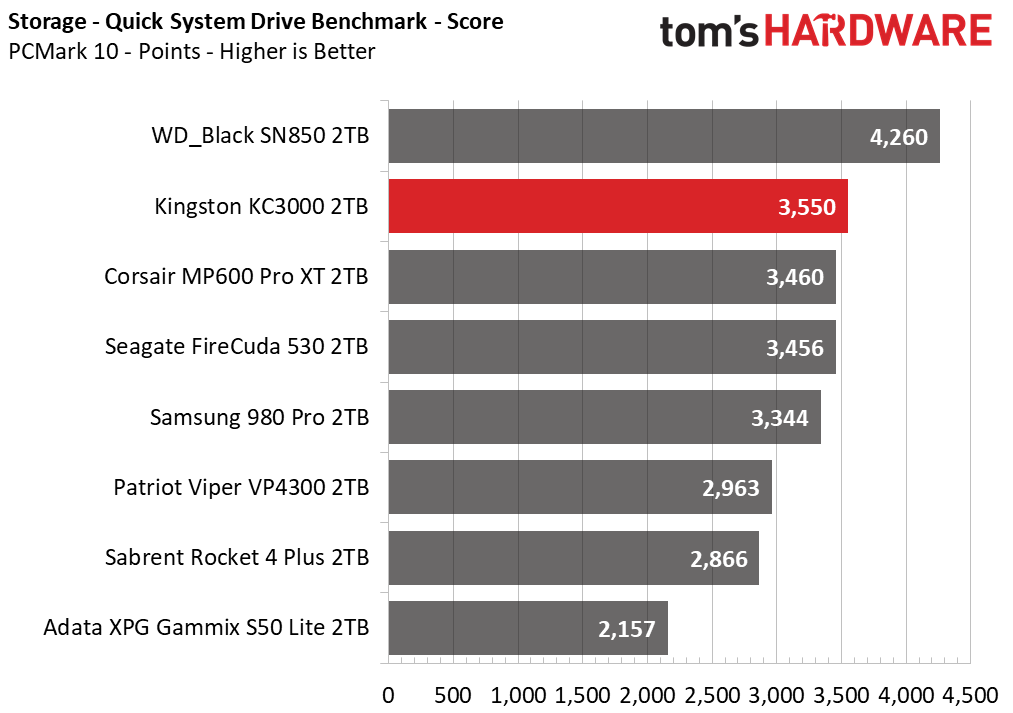

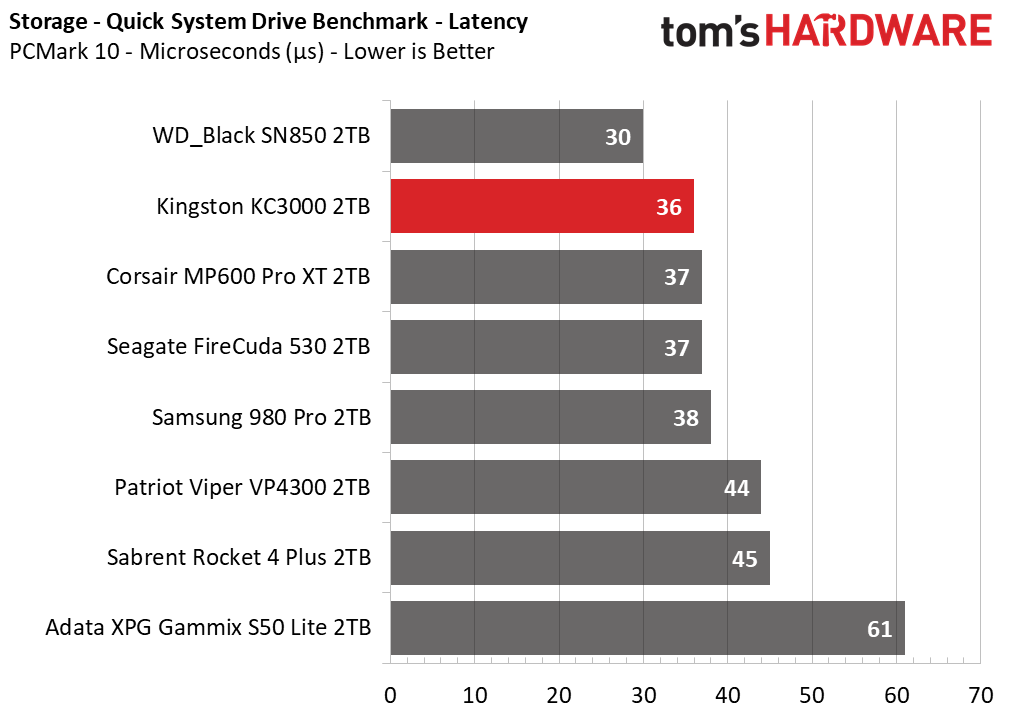



As fast at game loading and file transfers as the KC3000 is, the WD Black SN850 took off in PCMark 10’s workloads, reaching first place and leaving the Kingston in second. Again, the Seagate and Corsair couldn’t quite match the responsiveness that the Kingston KC300 provided nor could the Samsung 980 Pro.
Synthetic Testing - ATTO / CrystalDiskMark
ATTO and CrystalDiskMark (CDM) are free and easy-to-use storage benchmarking tools that SSD vendors use to assign performance specifications to their products. Both of these tools give us insight into how each device handles different file sizes.









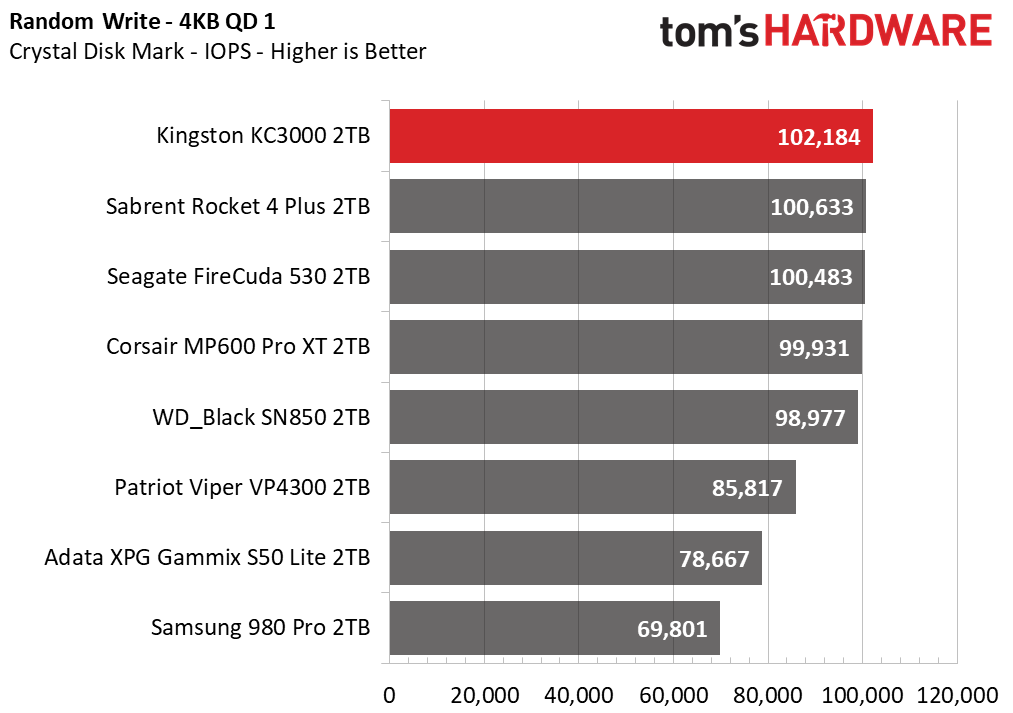




In both reads and writes, the Kingston KC3000’s sequential performance scaled well across most block sizes. It displayed not only the fastest sequential performance at a queue depth of one, but also delivered extremely fast random read and write performance that left its competitors behind.
Having scored roughly 400 read IOPs above Samsung’s 980 Pro at a QD of 1, the KC3000 delivered the fastest random performance of any NAND-based SSD we have touched, not to mention, its maximal random write performance hit nearly 1.6 million IOPS.
Sustained Write Performance and Cache Recovery
Official write specifications are only part of the performance picture. Most SSDs implement a write cache, which is a fast area of (usually) pseudo-SLC programmed flash that absorbs incoming data. Sustained write speeds can suffer tremendously once the workload spills outside of the cache and into the "native" TLC or QLC flash. We use Iometer to hammer the SSD with sequential writes for 15 minutes to measure both the size of the write cache and performance after the cache is saturated. We also monitor cache recovery via multiple idle rounds.





As for the KC3000’s SLC cache, it’s fully dynamic, meaning that it spans roughly one-third of the SSD’s available capacity. From empty, we wrote 730GB to Kingston’s KC3000 before its write speed started to degrade. Unlike the previous E18 + 176L competitors we’ve reviewed, the KC3000’s SLC cache is much larger and showed only one degradation stage from empty to full.
After saturating its SLC cache at a consistent 6.4GBps, the KC3000 wrote at roughly 1.6 GBps until it filled. The SLC cache didn’t recover at idle within our 30-minute test window but the drive’s write speed managed to improve to 3-4 GBps in each of the following test rounds.
Power Consumption and Temperature
We use the Quarch HD Programmable Power Module to gain a deeper understanding of power characteristics. Idle power consumption is an important aspect to consider, especially if you're looking for a laptop upgrade as even the best ultrabooks can have mediocre storage.
Some SSDs can consume watts of power at idle while better-suited ones sip just milliwatts. Average workload power consumption and max consumption are two other aspects of power consumption, but performance-per-watt is more important. A drive might consume more power during any given workload, but accomplishing a task faster allows the drive to drop into an idle state more quickly, ultimately saving energy.
We also monitor the drive’s temperature via the S.M.A.R.T. data and an IR thermometer to see when (or if) thermal throttling kicks in and how it impacts performance. Bear in mind that results will vary based on the workload and ambient air temperature.
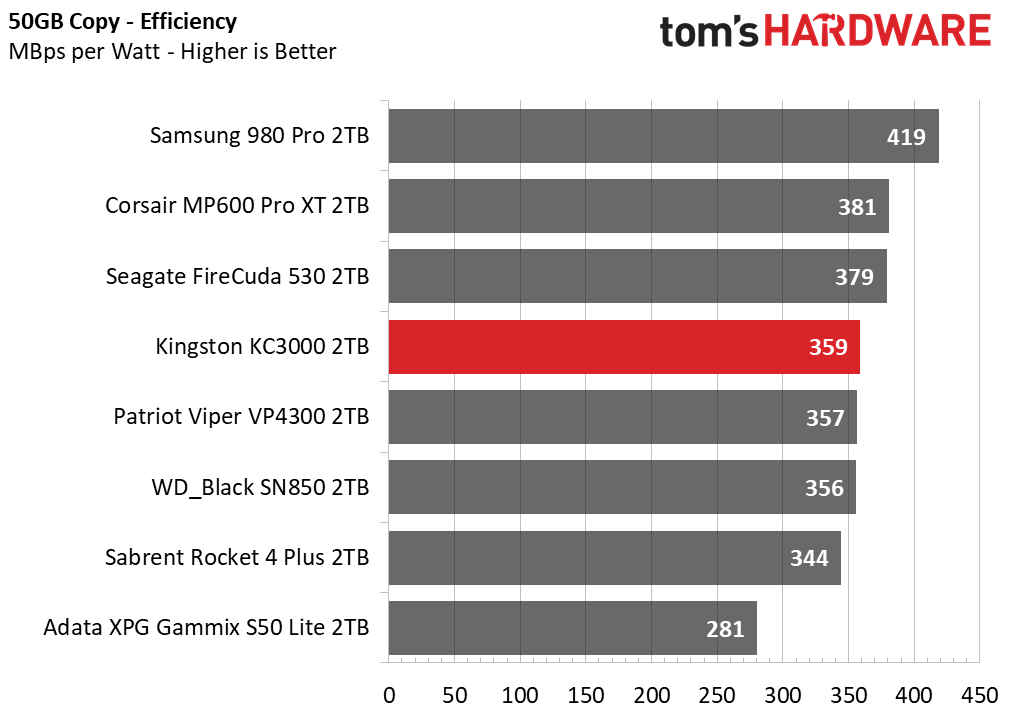



Kingston’s KC3000 displayed average efficiency under load when considering its copy performance, but overall, it was the most power-hungry M.2 SSD we tested. At idle, it also consumed over 1.1 watts, more power than either the Seagate FireCuda 530 or Corsair MP600 Pro XT.
As for the Kingston KC3000’s thermals, the heat spreader does a good job at distributing the heat across the componentry and away from the controller. When tested without airflow, the controller region of the heat spreader measured 78 degrees Celsius at its hottest once we wrote roughly 1TB of data to the SSD sequentially.
The thermal throttle temperature as reported by the S.M.A.R.T. data states it will throttle at 84 degrees Celsius, but the flash temperature can cause it to thermal throttle sooner. After absorbing 930GB of data from our transfer, the NAND package closest to the controller reached 70 degrees Celsius, causing the KC3000 to throttle. At idle, temperatures measured roughly 48 degrees Celsius with ASPM disabled.
Test Bench and Testing Notes
| CPU | Intel Core i9-11900K |
| Motherboard | ASRock Z590 Taichi |
| Memory | 2x8GB Kingston HyperX Predator DDR4 5333 |
| Graphics | Intel UHD Graphics 750 |
| CPU Cooling | Alphacool Eissturm Hurricane Copper 45 3x140mm |
| Case | Streacom BC1 Open Benchtable |
| Power Supply | Corsair SF750 Platinum |
| OS Storage | WD_Black SN850 2TB |
| Operating System | Windows 10 Pro 64-bit 20H2 |
We use a Rocket Lake platform with most background applications such as indexing, windows updates, and anti-virus disabled in the OS to reduce run-to-run variability. Each SSD is prefilled to 50% capacity and tested as a secondary device. Unless noted, we use active cooling for all SSDs.
Conclusion
Armed with the fastest flash to ship from Micron yet and Phison’s E18 SSD controller, Kington’s KC3000 delivered a very responsive performance that proved it’s one of the best SSDs right now. Unlike Seagate and Corsair, Kingston has unleashed what seems to be the E18’s full potential in KC3000.
In testing, the Kingston KC3000 edged out the Seagate FireCuda 530 and Corsair MP600 Pro XT and it delivered faster random 4K read speeds than even the Samsung 980 Pro, our previous (NAND-based) record-holder. Its aluminum and graphene label kept it cool enough under most heavy workloads and even managed well with no airflow.
While the flash interface speed played a big part in its victories, they were also achieved due in part to a larger dynamic SLC cache than compared to the Seagate and Corsair. Although the trade-off is a slower empty-to-fill time, the KC3000 is still tuned well for most gamers, prosumers, and storage enthusiasts.
If you are looking to upgrade your lightweight laptop, consider the Samsung 980 Pro or WD Black SN850, both of which are more power-efficient. The KC3000 also runs a bit thick at 2TB due to the double-sided PCB layout. It also lacks AES-256-bit encryption, but other than that we have little to complain about.
The 1TB capacity is priced aggressively, and at 2TB, as of press time, it’s priced less than both the Seagate and Corsair, making it a better buy. Samsung’s 980 Pro and the WD Black SN850, on the other hand, run $40-80 less, and Crucial’s P5 Plus is roughly $100 cheaper, making them better value picks.
Capable of top-tier performance, backed by a solid warranty and endurance ratings, and available in a broad range of capacities, the KC3000 is a solid, but costly buy for those who are looking for the best performance that they can get.
MORE: Best SSDs
MORE: How We Test HDDs And SSDs
MORE: All SSD Content

Sean is a Contributing Editor at Tom’s Hardware US, covering storage hardware.
-
Co BIY I disagree with the idea that hiding QR codes and other data on the back is a plus. On the principle that useful data should be placed in a readily accessible place.Reply
It would be interesting to run some of these drive tests on a new Z690 board test sled. If this is the fastest drive available it is most likely to demonstrate any possible benefit to the PCIe 5.0 interface.
Maybe one vendor needs to market a 3 TB drive ? The $600 jump is too much. Leaves a lot of market space in my mind. -
Alvar "Miles" Udell Would be interesting to see the 1TB results as well.Reply
Call me crazy too, but I'd still choose the Samsung 980 Pro, and I'm not just saying that because I HAVE one, the 1TB model...
-
BoredErica What CPU is being used to test the loading times these days? The 'how we test' article is old. Still using Haswell?Reply -
seanwebster Reply
Test bench and testing notes are above the conclusion. We are currently using an Intel i9-11900K and ASRock Z590 Taichi.dark_wizzie said:What CPU is being used to test the loading times these days? The 'how we test' article is old. Still using Haswell? -
plk2 Sean, would you explain your statement "If you are looking to upgrade your lightweight laptop, consider the Samsung 980 Pro or WD Black SN850, both of which are more power-efficient...". In reference to high temps, for my understanding and comparison uses, please explain why you pick the WD SN850 as a laptop upgrade over the Kingston KC3000 when based on your SN850 review. Your SN850 review stated that it runs to a peak of 92 deg-C vs. KC3000's 70 deg-C? During gaming, is the efficiency high enough to keep the temps down so the SN850 won't see the 92degsC during gaming? I appreciate the temperature information in your reviews. Most of the other reviewers don’t include data, let alone IR data to verify the S.M.A.R.T data. TYReply
reference: https://www.tomshardware.com/reviews/wd-black-sn850-m-2-nvme-ssd-review/3 -
seanwebster Reply
Hi, I reviewed the WD long before the KC3000 ever existed. The review is reflective of it’s time. Phison SSDs are very power hungry. If you want a SSD for laptops get a Samsung 980 pro, WD Black SN850, or if you don’t mind a little slower in some regard, the WD Black SN770 and SK hynix Gold P31. I did some laptop battery testing a little while ago that you can use as comparison reference.plk2 said:Sean, would you explain your statement "If you are looking to upgrade your lightweight laptop, consider the Samsung 980 Pro or WD Black SN850, both of which are more power-efficient...". In reference to high temps, for my understanding and comparison uses, please explain why you pick the WD SN850 as a laptop upgrade over the Kingston KC3000 when based on your SN850 review. Your SN850 review stated that it runs to a peak of 92 deg-C vs. KC3000's 70 deg-C? During gaming, is the efficiency high enough to keep the temps down so the SN850 won't see the 92degsC during gaming? I appreciate the temperature information in your reviews. Most of the other reviewers don’t include data, let alone IR data to verify the S.M.A.R.T data. TY
reference: https://www.tomshardware.com/reviews/wd-black-sn850-m-2-nvme-ssd-review/3
https://www.tomshardware.com/features/upgrading-your-laptop-with-pcie-40-storage-which-ssd-is-the-best
